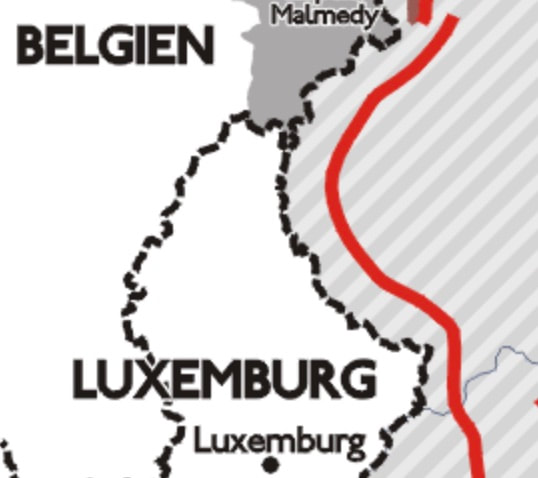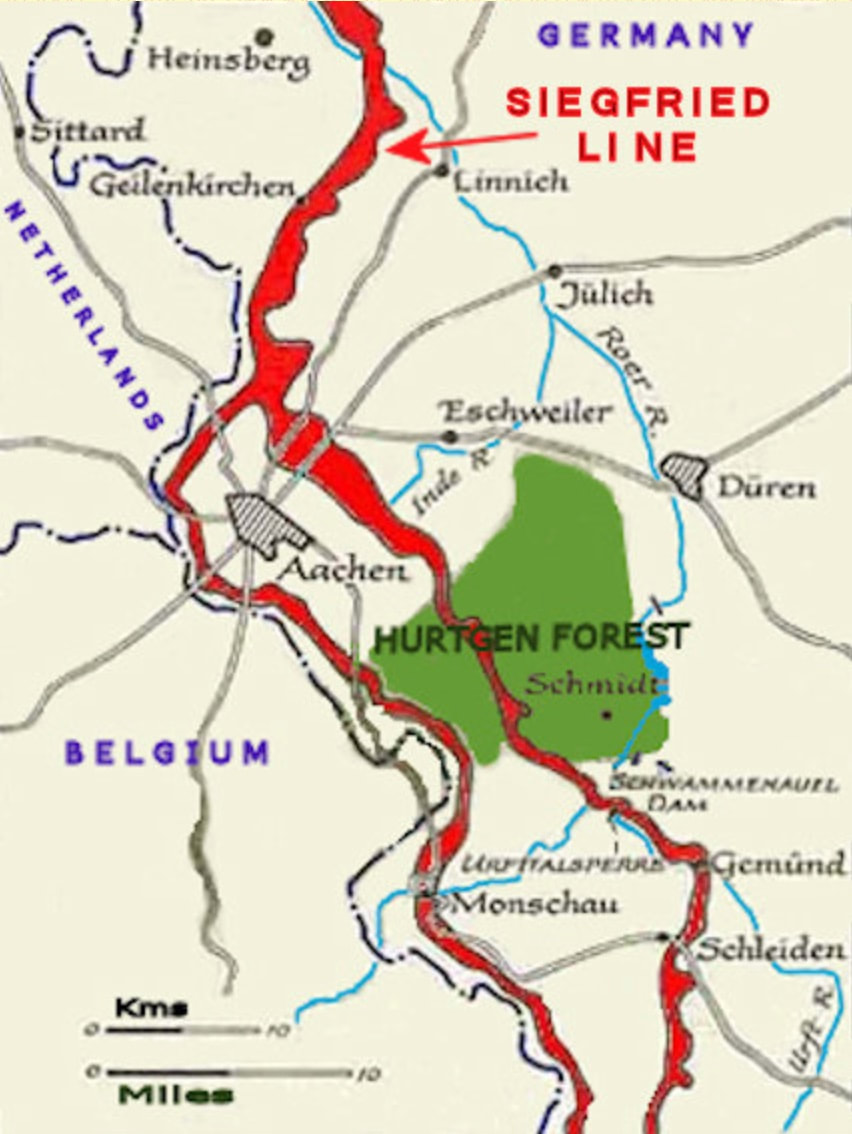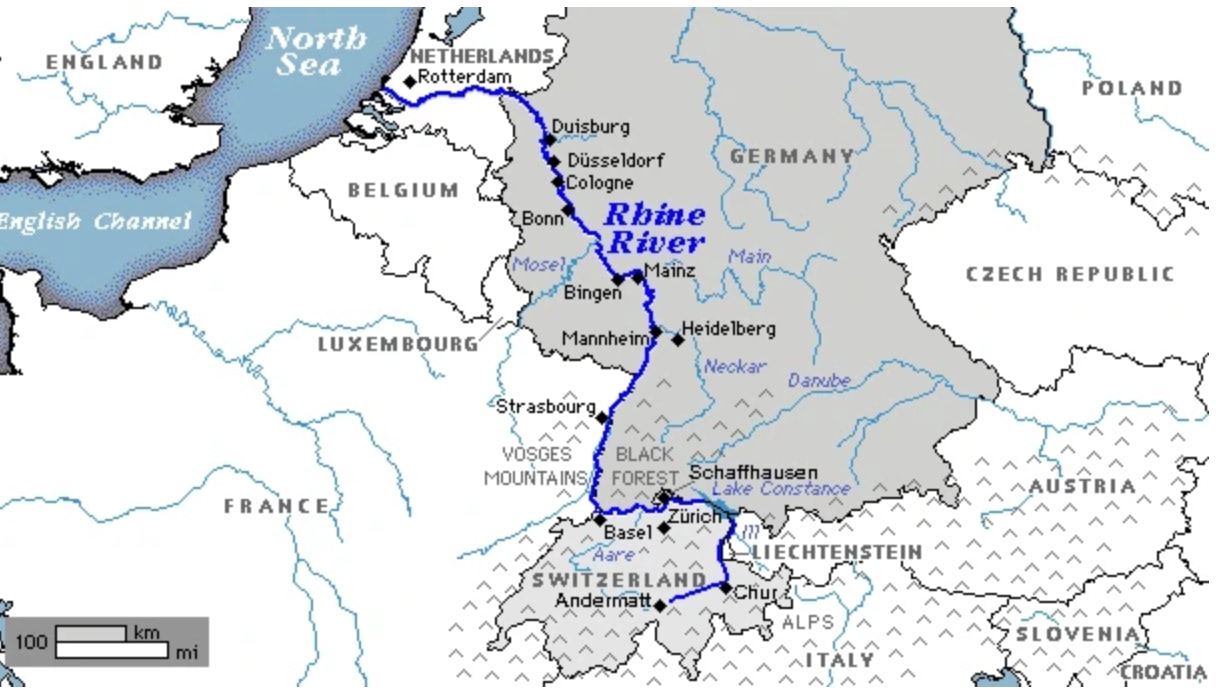bigpigeon.us webpage WWII Germany > The ETO > War of Attrition > Rhineland, 1944, © 2023 by Robert A. Christiansen, updated by RAC 31 Dec 2023.
This webpage and its affiliated webpages summarize US First and Ninth Army operations in the northern Rhineland from mid-September to mid-December 1944.
This webpage and its affiliated webpages summarize US First and Ninth Army operations in the northern Rhineland from mid-September to mid-December 1944.
Links to Big Pigeon's The ETO > War of Attrition > Rhineland, 1944 affiliated webpages:
- V Corps at the West Wall, September 1944
- Aachen, September-October 1944
- Hürtgen Forest, September-December 1944 (incomplete)
- Operation Queen, November-December 1944 (incomplete)
- Queen/Hürtgen, November-December 1944 (incomplete)
- The Last 1944 Offensives, December 1944 (incomplete)
Rhineland, 1944 Overview
As the Allies liberated Northern France, Belgium and Luxembourg in the late summer of 1944, German forces withdrew behind the Siegfried Line, also known as the West Wall, the fortified zone in the Rhineland just east of the German border. Further east lay the Rhine River and beyond it the heart of Germany.
|
In mid-September 1944, Allied commanders aspired to reach, and possibly cross, the Rhine before year end.
As the US First Army's V Corps crossed the German border from southeastern Belgium and Luxembourg, patrols discovered Siegfried Line positions were unoccupied. However, advances by V Corps' three divisions into the Siegfried Line and beyond soon encountered increasing German resistance. Within a week, V Corps had withdrawn. This was not seen as a great loss, since from this sector routes to Rhine River were longer and more-difficult than further north. To the north, on the preferred invasion route, First Army's VII Corps approached the Germany border through eastern Belgium. Here, two obstacles lay in its path to the Rhine:
VII Corps penetrated the outer ring of the Siegfried Line south of Aachen in mid-September. Within the First Army, hopes were high - Cologne and the Rhine River were a scant 50 miles east of Aachen across hospitable terrain. Three major US offensives in this area of the Rhineland then ensued from September to December 1944:
In mid-December, after these offensives ended and with thousands of US Army dead, the Roer River had not yet been crossed. |
Here us a timeline of major fall 1944 ETO activity in the German Rhineland:
- 12 September - Beginning of combat in the Aachen area. The US and German Armies send reinforcements, Aachen is eventually encircled and after combat in the streets finally falls on 21 Oct.
- 19 September - First skirmishes near the Hürtgen Forest, southeast of Aachen. The Battle of the Hürtgen Forest, actually a complex series of battles, lasted for months.
- October - US Ninth Army moves from Brittany to Luxembourg and is then positioned north of Aachen on the left flank of the US First Army.
- 16 November - First and Ninth Armies begin Operation Queen, advancing to the Roer River.
- 16 December - The massive Germany counterattack in the Ardennes known as the Battle of the Bulge begins. All Allied offensive activities in the ETO are soon cancelled to deal with the attempted German breakthrough.
|
The scope of this webarea:
The Rhineland Campaign, as defined by the US Army, includes all offensive action in the ETO during the period 15 September 1944 - 21 March 1945, whether in Germany, France, Belgium, Luxembourg, or the Netherlands. This is unfortunate, since the Rhineland lies entirely in Germany. This webarea considers only major actions by the First and Ninth Armies within Germany itself during 1944. Most actions were confined to the small portion of the northern Rhineland in the Aachen area. |
Finally, on 9 Feb 1945, First Army units captured the key Roer River dam, but too late to prevent downstream flooding.
After the German Ardennes Counteroffensive began on 16 December 1944, the First Army's VII Corps headquarters and units of the First and Ninth Armies were sent to blunt the German attack and bolster the northern portion of the Bulge. The Ninth Army's sector was enlarged to cover the front previously covered by VII Corps. The Ninth Army then held this front, most of which remained inactive, until late February 1945.
After the German Ardennes Counteroffensive began on 16 December 1944, the First Army's VII Corps headquarters and units of the First and Ninth Armies were sent to blunt the German attack and bolster the northern portion of the Bulge. The Ninth Army's sector was enlarged to cover the front previously covered by VII Corps. The Ninth Army then held this front, most of which remained inactive, until late February 1945.
Sources for Big Pigeon's The ETO > War of Attrition > Rhineland, 1944 webpage:
Major Sources:
Pottawattamie Area WWII Dead - The ETO > War of Attrition > Rhineland, 1944:
Major Sources:
- The Siegfried Line Campaign (from the United States Army in World War II, European Theater of Operations series, by Charles B. MacDonald, 1963) - www.ibiblio.org/hyperwar/USA/USA-E-Siegfried/index.html.
- The Mid-Rhineland Border Area map, https://upload.wikimedia.org/wikipedia/commons/4/47/Karte_westwall.png.
- The North Rhineland Border Area, map is courtesy of http://home.scarlet.be/~sh446368/home.html
- The Rhine River - map found at turtledove.fandom.com.
- https://www.ibiblio.org/hyperwar/USA/USA-E-Siegfried/maps/USA-E-Siegfried-VII.jpg
- The Ninth Army ... at the Roer map is excerpted from a map I found at pinterest.
Pottawattamie Area WWII Dead - The ETO > War of Attrition > Rhineland, 1944:
- Taken from the bigpigeon.us WWII Dead module.
- The remaining Fall 1944 Rhineland dead are listed in subsequent subpages.
- unknown unit, assigned to First Army one day before death; KIA 22 Nov 1944, near Aachen, North Rhine-Westphalia, Germany; The ETO > War of Attrition > Rhineland 1944.






